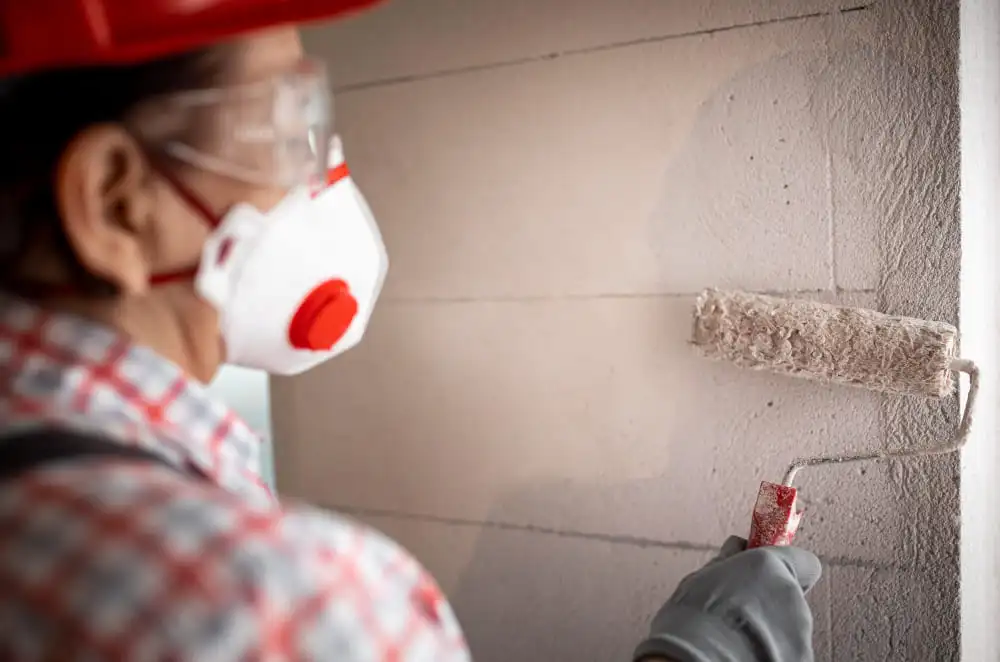What’s the Best Paint for Outdoor Concrete?

Top Factors to Consider Before Choosing Concrete Paint
Selecting the right paint for concrete surfaces requires careful consideration to ensure durability, appearance, and safety. Here are the key factors to evaluate:
Durability and Foot Traffic Resistance
Concrete floors and surfaces often endure heavy use. Choose paint formulated to withstand abrasion, impacts, and frequent foot traffic without peeling or wearing quickly.
UV and Weather Resistance
If painting outdoor concrete, the paint must resist fading, chalking, and degradation caused by sun exposure, rain, and temperature fluctuations.
Moisture & Mold Resistance
Concrete can absorb moisture, so paint should offer strong resistance to water penetration and inhibit mold or mildew growth, especially in damp or humid environments.
Adhesion Strength and Flexibility
Good adhesion is crucial to prevent peeling or flaking. Paint should also be flexible enough to accommodate minor concrete expansion and contraction without cracking.
Color Retention and Finish Options
Look for paints that maintain their color vibrancy over time. Consider available finishes—matte, satin, gloss—that suit your aesthetic and functional needs.
Safety: Non-Slip and Low VOCs
For flooring, non-slip additives improve safety. Also, low-VOC (volatile organic compounds) paints reduce harmful fumes, making them safer for indoor use.
Maintenance Needs and Longevity
Consider how often the painted surface will need touch-ups or recoating. Some concrete paints offer long-lasting protection with minimal upkeep.
Best Types of Paint for Outdoor Concrete Surfaces
Acrylic Concrete Paint
- Water-based, easy to apply and clean up
- Good UV resistance and color retention
- Flexible and breathable, reducing cracking
- Best for patios, walkways, and driveways with moderate traffic
Epoxy-Based Paints
- Extremely durable and resistant to chemicals and abrasion
- Provides a hard, glossy finish
- Requires careful surface prep and often professional application
- Ideal for garages, high-traffic areas, and industrial outdoor spaces
Latex-Based Paints
- Water-based and user-friendly
- Less durable than epoxy but good for decorative applications
- Dries quickly with low odor
- Suitable for vertical concrete surfaces like walls and fences
Polyurethane Coatings
- Provides excellent UV resistance and durability
- Flexible with strong adhesion
- Often used as a topcoat over epoxy or acrylic paints for added protection
- Great for surfaces exposed to sun and weather
Polyaspartic Finishes
Fast-curing with high durability
Excellent chemical, abrasion, and UV resistance
More expensive but ideal for commercial or heavy-use areas
Can be applied in a wide temperature range
Oil-Based Paints
- Durable with good adhesion
- Longer drying times and stronger fumes
- Less environmentally friendly
- Suitable for specific industrial or restoration projects
Anti-Slip Additives and Finishes
- Can be mixed into or applied over paint
- Improve safety on wet or slippery surfaces
- Essential for walkways, ramps, and pool decks
Concrete Stains vs Paint: Key Differences
| Aspect | Concrete Stains | Concrete Paint |
| Appearance | Penetrates surface; natural look with translucent color | Coats surface; opaque and solid color |
| Durability | Long-lasting, less prone to peeling | Can chip or peel; may require recoating |
| Maintenance | Low maintenance; doesn’t peel | May need touch-ups and reapplication |
| Application | More subtle, requires porous surface | Covers imperfections; more versatile |
Preparing Outdoor Concrete for Painting
. Clean the Surface Thoroughly
- Remove dirt, dust, grease, oil, and any loose debris using a stiff broom, pressure washer, or concrete cleaner.
- For stubborn stains, use a degreaser or trisodium phosphate (TSP) solution.
- Let the surface dry completely before proceeding.
. Repair Cracks and Imperfections
- Fill cracks, holes, or spalling areas with a concrete patch or filler.
- Smooth out repairs with a putty knife or trowel.
- Allow sufficient drying/curing time as per product instructions.
. Etch or Sand the Surface
- Etching opens the concrete’s pores for better paint adhesion. Use a concrete etcher or muriatic acid solution following safety guidelines.
- Alternatively, sand rough or glossy surfaces to create a texture that paint can grip.
- Thoroughly rinse after etching and let dry.
. Check for Moisture Issues
- Ensure the concrete is fully dry and free from moisture rising from below (moisture vapor transmission).
- Consider a moisture test or use a moisture barrier if needed to prevent peeling or bubbling.
. Apply a High-Quality Primer
- Use a primer specifically designed for concrete and outdoor use.
- Primer improves paint adhesion, seals the surface, and extends durability.
- Follow manufacturer instructions for application and drying time before painting.
Step-by-Step: How to Paint Outdoor Concrete Like a Pro
1. Choose the Right Paint for the Job
Select a paint designed for outdoor concrete—acrylic, epoxy, or polyurethane-based paints work best depending on your needs.
2. Stir and Test Paint Before Use
- Thoroughly stir the paint to mix all components evenly.
- Test a small inconspicuous area to ensure good adhesion and color appearance.
3. Apply the First Coat Evenly
- Use a roller with a thick nap for rough surfaces or a brush for edges and corners.
- Apply paint in thin, even layers to avoid drips and pooling.
- Work in manageable sections for consistent coverage.
4. Allow Proper Dry Time
- Follow manufacturer’s recommended drying time before applying the next coat.
- Avoid painting in extreme temperatures or high humidity to ensure proper drying.
5. Apply Second (and Optional Third) Coat
- Apply a second coat for full coverage and durability.
- A third coat can be added for extra protection in high-traffic or harsh weather areas.
6. Finish with a Durable Concrete Sealer
- Once paint is fully dry, apply a clear concrete sealer to protect against wear, UV damage, and moisture.
- Choose a sealer compatible with your paint type and environment (matte, satin, or glossy finish).
Maintaining Your Painted Outdoor Concrete
1. Regular Cleaning with Mild Detergents
- Sweep or hose down the surface regularly to remove dirt and debris.
- Clean with a gentle soap or mild detergent and a soft-bristle brush to avoid damaging the paint.
2. Avoid Harsh Chemicals or Power Washers
- Strong chemicals can degrade paint and sealants.
- Use power washers cautiously and on a low-pressure setting to prevent paint peeling or chipping.
3. Touch-Up Chips and Fading Areas
- Inspect your concrete periodically for chips, cracks, or fading.
- Promptly touch up worn spots with matching paint to prevent further damage.
4. Reapply Sealant Every Few Years
- Sealers wear down over time, especially in harsh weather.
- Plan to reapply a compatible concrete sealer every 2–3 years for continued protection.
5. Protect From Heavy Furniture & Abrasive Materials
- Use furniture pads or mats under heavy items to prevent scratching or gouging.
- Avoid dragging heavy or sharp objects directly across the surface.
Cost Breakdown: How Much Does Concrete Paint Cost?
1. Average Cost per Gallon (By Type)
| Paint Type | Approximate Cost per Gallon |
| Acrylic Concrete Paint | $25 – $50 |
| Epoxy-Based Paints | $50 – $100 |
| Latex-Based Paints | $20 – $40 |
| Polyurethane Coatings | $60 – $120 |
| Polyaspartic Finishes | $100 – $150 |
| Oil-Based Paints | $30 – $60 |
2. DIY vs Professional Labor Costs
- DIY:
- Paint and materials only.
- Cost savings but requires time, skill, and proper prep.
- Tools may add $50–$150 if not already owned.
- Professional:
- Labor costs typically $1.50–$4.00 per sq. ft. depending on region and job complexity.
- Includes prep, painting, and clean-up.
- Total cost can range from $500 to several thousand dollars for large areas.
3. Cost Factors: Prep, Tools, & Number of Coats
- Surface Prep: Cleaning, repairing, sanding, and priming may add $50–$200 in materials and time.
- Tools: Rollers, brushes, sprayers, tape, and safety gear might cost $50–$150.
- Number of Coats: More coats increase paint volume and labor, raising costs proportionally. Usually, 2 coats are recommended for durability.
Real-World Examples & Paint Recommendations
Here’s a quick guide to the best paint choices for different concrete surfaces, plus expert brand picks for 2025:
Best for Patios & Walkways
- Recommended Paint Types: Acrylic concrete paint or latex-based paint
- Why: Flexible, breathable, and good UV resistance for moderate foot traffic
- Example: A backyard patio refreshed with Behr’s Premium Acrylic Concrete & Garage Floor Paint — vibrant color and easy application.
- Tips: Add anti-slip additives for safety.
Best for Driveways & Garages
- Recommended Paint Types: Epoxy-based paint or polyaspartic finishes
- Why: Superior durability, chemical resistance, and ability to withstand heavy vehicle traffic
- Example: Garage floor coated with Rust-Oleum EpoxyShield — glossy, hard-wearing finish that resists oil stains and wear.
- Tips: Proper surface prep is essential to prevent peeling.
Best for Pool Decks & Moist Environments
- Recommended Paint Types: Polyurethane coatings or specialized pool deck paints with waterproof and anti-slip properties
- Why: Excellent moisture resistance and UV stability to handle constant exposure to water and sun
- Example: Drylok Extreme Masonry Waterproofer used around pool areas for added protection against water intrusion.
- Tips: Choose light colors to reduce heat absorption.
Expert Picks: Top Brands in 2025
| Brand | Best For | Notable Products |
| Behr | Patios, walkways, light traffic | Premium Acrylic Concrete & Garage Floor Paint |
| Rust-Oleum | Garages, driveways, heavy use | EpoxyShield, Concrete Floor Coating |
| KILZ | Primers & sealers for concrete | KILZ Concrete & Masonry Primer |
| Drylok | Waterproofing & pool decks | Drylok Extreme Masonry Waterproofer |
FAQs About Painting Outdoor Concrete
Q1: Can I paint concrete without priming?
Priming is highly recommended as it improves paint adhesion, seals the surface, and extends the life of your paint job—especially for outdoor concrete exposed to weather.
Q2: How long does concrete paint last outdoors?
With proper prep, quality paint, and sealing, outdoor concrete paint can last 3–7 years, depending on traffic and weather exposure.
Q3: Can I paint over existing concrete paint?
Yes, but you must clean, sand, and prime the surface first to ensure the new paint adheres well and doesn’t peel.
Q4: What’s the best time of year to paint outdoor concrete?
Paint when temperatures are between 50°F and 85°F with low humidity for optimal drying and curing.
Q5: How do I prevent slipping on painted concrete?
Add non-slip additives to your paint or apply a textured sealer to increase traction, especially in wet areas like patios or pool decks.
Q6: Can I use interior paint on outdoor concrete?
No, interior paints aren’t formulated to handle UV rays, moisture, and temperature changes; always use exterior-grade concrete paint.
Make An Appointment
Do You Need A Professional Painter? Fill Out This Form To Get In Touch.
Every day from
8:00 — 18:00
Call to ask any question
